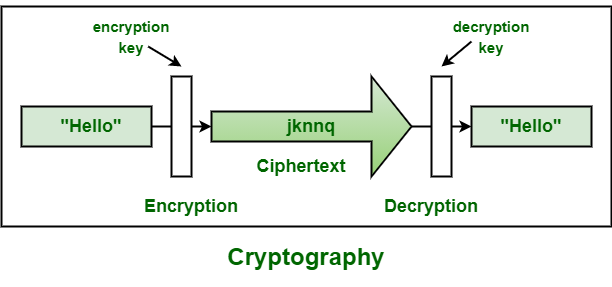1.加密:
顾名思义,加密通常是一种用于使用算法隐藏消息的技术。密码学的基本应用是使用算法对消息进行编码。通常,它有助于保护私人信息,敏感数据,并增强客户端应用程序和服务器之间通信的安全性。它被认为是最有效和流行的数据安全技术之一。
例子 :

2.密码学:
顾名思义,密码学通常是对诸如加密之类的方法的研究。它的主要目的是提供简单的方法,以使用加密和相关技术来保护和保护信息和通信。它仅允许一个人存储敏感信息或在不安全的网络上传输它,从而使除预期收件人之外的任何人都无法读取或访问它。它的功能包括身份验证,不可否认性,机密性和完整性。
例子 :

加密和密码学之间的区别:
|
Encryption |
Cryptography |
|---|---|
| It is a process of encoding message or information so that only authorized parties can have access to it. | It is study of techniques such as encryption for secure communication in presence of third parties. |
| It is considered as principal application of cryptography. | It is considered as art of creating codes using techniques of encryption and decryption. |
| It simply uses algorithm to encrypt data and secret key to decrypt it. | It simply provides methods of protecting data through encryption and its related processes. |
| It is all about mathematical and algorithmic in nature. | It is all about techniques and technologies in nature. |
| Its main purpose is confidentiality that means concealing content of message by translating it into code. | Its main purpose is to apply complex mathematics and logic to design strong encryption methods. |
| Types of encryption includes symmetric and asymmetric encryption. | Types of cryptography includes symmetric key cryptography and asymmetric key cryptography. |
| It provides security to data all times, maintains integrity, protects privacy, protects data across devices, etc. | In provides techniques like encryption techniques that can guard information and communication, cryptographic technique like MAC and digital signatures to protect information against spoofing and forgeries. |
| It follows same approach with some terms like ciphertext, plaintext, and cipher. | It has symmetric and asymmetric version with concept of shared and non-shared key. |
| It is useful to modern data security such as digital signatures and protect sensitive electronic data such as emails and passwords. | It is useful in electronic commerce, military communications, chip-based card payments, digital currencies, time stamping, etc. |